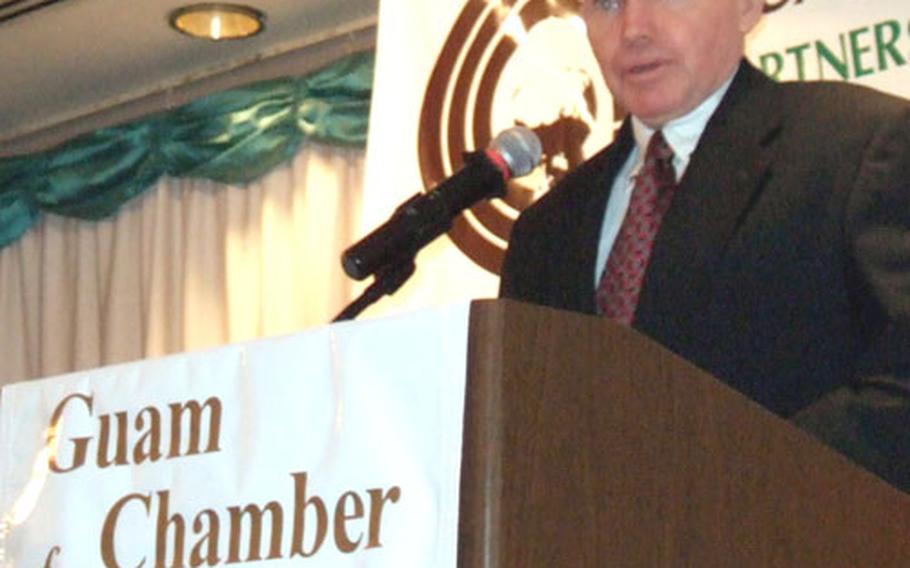
Retired Marine Corps Maj. Gen. David Bice, executive director of the Joint Guam Program Office, speaks to the Guam Chamber of Commerce on Friday. His office will oversee the relocation of 8,000 Marines to Guam. (Frank Whitman / Stars and Stripes)
The head of the office that will oversee the relocation of 8,000 Marines stressed to Guam leaders during a five-day visit that he would work closely with the local community.
“There are no secrets,” said retired Marine Corps Maj. Gen. David Bice on Tuesday while addressing the Guam Governor’s Military Civilian Task Force, which deals with issues related to the realignment. “We want you as members of our team.”
Bice and B.J. Penn, assistant secretary of the Navy for installations and environment, who earlier this month named Bice to head the Joint Guam Program Office, kicked off the visit Friday by talking to the Guam Chamber of Commerce.
Penn told the group the realignment to Guam — which, as currently planned, will see $10 billion to $14 billion spent to move 8,000 to 12,000 servicemembers and their families to the island — is among the largest projects DOD has ever attempted.
Bice emphasized a desire to work with the Guam community so that the realignment will be beneficial to the military and to the community.
“It’s good for the strategic interests of America,” said Bice, who will operate two offices, one on Guam and one in Washington, each with 25 to 30 personnel. “It’s good for our friends in the Pacific and it’s also good for Guam.”
He indicated a desire to help Guam train local workers and to facilitate industry and small-business forums on accessing the job and business opportunities that will accompany the buildup.
A team of Japanese and American technical experts also was on Guam, Bice said, assessing “public services” — wastewater treatment, solid waste handling, power generation and similar infrastructure capacity.
“We’ll be talking to the Guam public service directors and their engineers about what we can get from them and what they can expect from us,” he said. “We want to team with the public services here in Guam. We don’t want to build this stuff inside the fence line on Department of Defense land.
“We want to team. We want to be paying customers and where we can do that, we will in fact do it,” Bice told the Chamber.
The Marines relocation is slated to be completed by 2014 as agreed by the governments of the United States and Japan. Penn and Bice said that’s still their goal, but made mention that construction can only begin after an environmental study is completed.
The study is expected to begin Feb. 1 with the release of a National Environmental Policy Act notice of intent by Bice’s office.
Bice, who emphasized the military’s commitment to responsible environmental stewardship, said construction will span five or more years.
“It’s a stated goal between the United States and Japan to complete [THE MOVE]by 2014,” Bice said. “We see lots of difficulties in achieving that, but it’s still our goal and we’re going to be working that.”